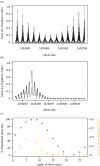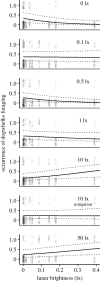Artificial light at night reverses monthly foraging pattern under simulated moonlight
- PMID: 35892207
- PMCID: PMC9326264
- DOI: 10.1098/rsbl.2022.0110
Artificial light at night reverses monthly foraging pattern under simulated moonlight
Abstract
Mounting evidence shows that artificial light at night (ALAN) alters biological processes across levels of organization, from cells to communities. Yet, the combined impacts of ALAN and natural sources of night-time illumination remain little explored. This is in part due the lack of accurate simulations of the complex changes moonlight intensity, timing and spectra throughout a single night and lunar cycles in laboratory experiments. We custom-built a novel system to simulate natural patterns of moonlight to test how different ALAN intensities affect predator-prey relationships over the full lunar cycle. Exposure to high intensity ALAN (10 and 50 lx) reversed the natural lunar-guided foraging pattern by the gastropod mesopredator Nucella lapillus on its prey Semibalanus balanoides. Foraging decreased during brighter moonlight in naturally lit conditions. When exposed to high intensity ALAN, foraging increased with brighter moonlight. Low intensity ALAN (0.1 and 0.5 lx) had no impact on foraging. Our results show that ALAN alters the foraging pattern guided by changes in moonlight brightness. ALAN impacts on ecosystems can depend on lunar light cycles. Accurate simulations of night-time light cycle will warrant more realistic insights into ALAN impacts and also facilitate advances in fundamental night-time ecology and chronobiology.
Keywords: artificial light at night; foraging; lunar biology; lunar cycles; moonlight; sensory ecology.
Figures


Similar articles
-
Effects of artificial light at night on the foraging behavior of an endangered nocturnal mammal.Environ Pollut. 2020 Aug;263(Pt A):114566. doi: 10.1016/j.envpol.2020.114566. Epub 2020 Apr 11. Environ Pollut. 2020. PMID: 32320890
-
Endogenous cycles, activity patterns and energy expenditure of an intertidal fish is modified by artificial light pollution at night (ALAN).Environ Pollut. 2019 Jan;244:361-366. doi: 10.1016/j.envpol.2018.10.063. Epub 2018 Oct 16. Environ Pollut. 2019. PMID: 30352350
-
Artificial light at night alters trophic interactions of intertidal invertebrates.J Anim Ecol. 2017 Jul;86(4):781-789. doi: 10.1111/1365-2656.12670. Epub 2017 Apr 27. J Anim Ecol. 2017. PMID: 28452048
-
The impacts of artificial light at night on the ecology of temperate and tropical reefs.Philos Trans R Soc Lond B Biol Sci. 2023 Dec 18;378(1892):20220362. doi: 10.1098/rstb.2022.0362. Epub 2023 Oct 30. Philos Trans R Soc Lond B Biol Sci. 2023. PMID: 37899007 Free PMC article. Review.
-
Impacts of artificial light at night in marine ecosystems-A review.Glob Chang Biol. 2022 Sep;28(18):5346-5367. doi: 10.1111/gcb.16264. Epub 2022 Jun 14. Glob Chang Biol. 2022. PMID: 35583661 Free PMC article. Review.
Cited by
-
Introduction of artificial light at night increases the abundance of predators, scavengers, and parasites in arthropod communities.iScience. 2023 Feb 14;26(3):106203. doi: 10.1016/j.isci.2023.106203. eCollection 2023 Mar 17. iScience. 2023. PMID: 36876132 Free PMC article.
-
Impacts of artificial light at night on the early life history of two ecosystem engineers.Philos Trans R Soc Lond B Biol Sci. 2023 Dec 18;378(1892):20220363. doi: 10.1098/rstb.2022.0363. Epub 2023 Oct 30. Philos Trans R Soc Lond B Biol Sci. 2023. PMID: 37899009 Free PMC article.
-
Long-term exposure to experimental light affects the ground-dwelling invertebrate community, independent of light spectra.Philos Trans R Soc Lond B Biol Sci. 2023 Dec 18;378(1892):20220364. doi: 10.1098/rstb.2022.0364. Epub 2023 Oct 30. Philos Trans R Soc Lond B Biol Sci. 2023. PMID: 37899017 Free PMC article.
-
Darkening of the Global Ocean.Glob Chang Biol. 2025 May;31(5):e70227. doi: 10.1111/gcb.70227. Glob Chang Biol. 2025. PMID: 40421554 Free PMC article.
References
-
- Tidau S, et al. 2021. Marine artificial light at night: an empirical and technical guide. Methods Ecol. Evol. 12, 1588-1601. (10.1111/2041-210X.13653) - DOI
Publication types
MeSH terms
Associated data
LinkOut - more resources
Full Text Sources

